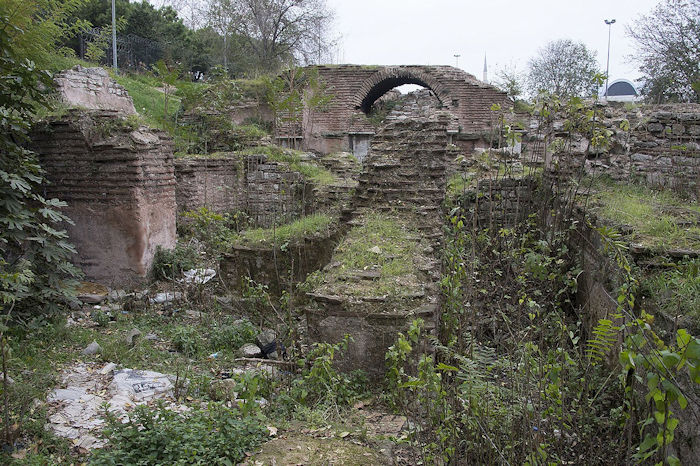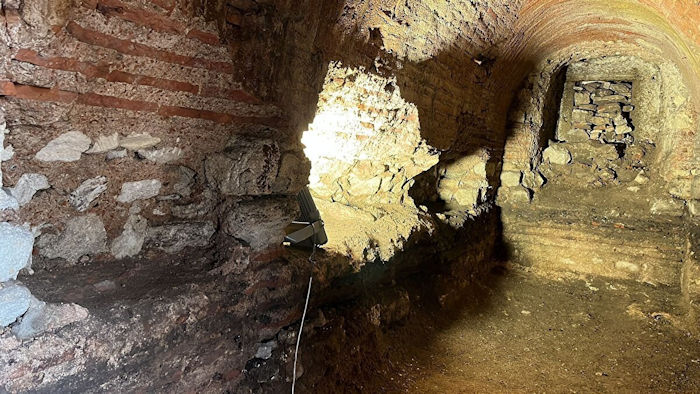Conny Waters - AncientPages.com - A previously unknown underground tunnel estimated to be about 1,500 years have been unearthed during ongoing archaeological excavations in 1,500-year-old St. Polyeuktos Church in Istanbul's Saraçhane Archaeological Park in Turkey.
The church was an ancient Byzantine church in Constantinople (now Istanbul, Turkey) built by the noblewoman Anicia Juliana (granddaughter of Valentinian III), whose name is known from an illuminated manuscript dated 512.
Ancient ruins of the Church of St. Polyeuctus. Credit: Dosseman - CC BY-SA 4.0
Polyeuktos was an ancient Roman saint. Christian tradition states that he was a wealthy Roman army officer, the first martyr in Melitene, Armenia, under Emperor Valerian.
In recent days excavation works carried out by Istanbul Metropolitan Municipality (IBB) teams have been a success. Archaeologists have unearthed a secret underground passageway "about 20 meters (65 feet) from the nearby Hasim Isçan Passage. The underground passage, which contains mosaics and stone inlays, has impressed researchers with its carved marble blocks and relief," the Daily Sabah reports.
According to Istanbul Metropolitan Municipality (IBB) Deputy Secretary-General Mahir Polat, the ancient structure is an excellent example of the city's architecture that has stood the test of time and the wrath of earthquakes.
A 1,500-year-old secret tunnel was discovered in Istanbul, Turkey. Credit: DHA Photo
"We have excavated the ruins of St. Polyeuktos Church, the first example of this architectural style in the world. We will continue with excavations while people are visiting. We will have the chance to explain both 'what is archaeology?' and the meaning of the historic structure.
More importantly, we can explain why it's so special to be able to see a 1,500-year-old passage. Istanbul, which is currently struggling with earthquakes, has experienced dozens of earthquakes over the past 1,500 years. However, the structure we are seeing now has managed to survive all earthquakes. We should learn lessons from this," Polat said adding that the Saraçhane Archaeological Park will open for visitors in a month's time.
The ancient tunnel has survived earthquakes and other catastrophes. Credit: DHA Photo
The Church of Saint Polyeuktos was built between 524 and 527. Although only ruins remain from the church, it remains an important place shedding light on an important period in Byzantine history.
During the construction of an underpass in the 1960s, a number of ancient artifacts were found, and the finds prompted scientists to carry out excavation works among the ruins of the church. One of the artifacts was dedicated to Asclepieion, the god of medicine in ancient Greece.
"The Polyeuktos Church's ruins will be exactly 1,500 years old soon. Yet, there were also buildings in the Roman period before the Polyeuktos Church was built on this site. After it was destroyed, there were also different buildings in the Ottoman period. This is a truly unique point for Istanbul's urban archaeology.
We are in a collection of buildings that are almost a summary of Istanbul, which was the capital of three empires. Since June 2022, we have started intensive excavation work and re-planning of the site. This building complex represents a unique momentum in Byzantine history and subsequent periods of the world's architectural history.
The aerial view of the archeological site in Saraçhane Archaeology Park where the Church of St. Polyeuctus is located. Credit: DHA Photo
An ancient Roman statue was found at the site. Credit: DHA Photo
It was built just before the Hagia Sophia as the most magnificent example of the 'domed basilica' architectural style. We think that Hagia Sophia was built to be pit against the church," Polat told the Daily Sabah.
At the site, archaeologists found an ancient Roman statue. Preliminary studies show that the "marble statue's head, legs and right arm were broken at shoulder height. The figure, dressed in a himation that leaves the upper right part of its body uncovered, is thought to belong to the Roman period. The exact age and period of the statue will be determined after further examination."
See also: More Archaeology News
As reported by Daily Sabah, "about the statue, Polat emphasized: "Istanbul is a place where history really springs from its soil. Think about it, a significant Roman statue can be found 1 meter below ground level after thousands of years. In this respect, with our studies, we think that this finding, a Roman-period statue, dates back to the A.D. second century. With these studies, we hope to find the lost head or other parts of the body.
Istanbul will continue to gain new artifacts through urban archaeology and will establish more prestigious archaeological parks or sites."
All the unearthed ancient artifacts will be available to the public as the area opens in a month.
Written by Conny Waters - AncientPages.com Staff Writer








